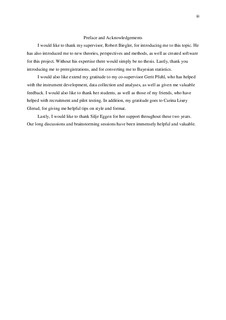| dc.description.abstract | The phenotypic behaviour associated with psychosis and autism spectrum disorder have been theorised to stem from diametrically opposite tendencies in mental state attribution, thereby placing the phenotypes on opposite ends of a mentalising dimension. By extending this mentalsinig dimension to agency attribution, this model supplements Bayesian theories that argue that false prediction errors cause of behaviour associated with psychosis and autism spectrum disorder. The aim of the present study was therefore to investigate whether tendencies towards psychosis and autism spectrum disorder relates to opposite tendencies in agency attribution. A chasing detection task was modified for the present study. Participants from the general population completed the visual search task, in which the goal was to identify chasing motion in artificial stimuli. In line with predictions, psychotic traits were associated with a bias to see chasing. In contrast, no conclusive evidence was found that indicated that autistic traits were related to a bias to not see chasing. In addition, an oddity was identified when examining the relationship between bias and ability to detect chasing. The implication of these findings and recommendations for further research were discussed. | nb_NO |
